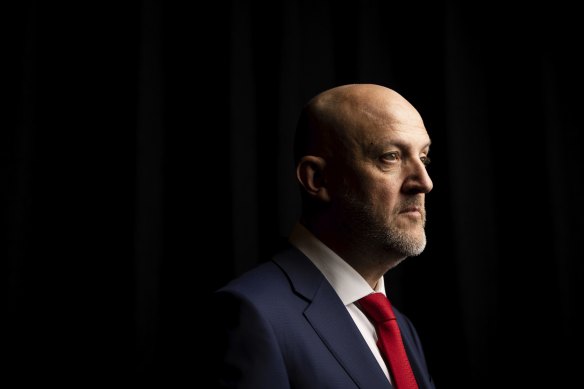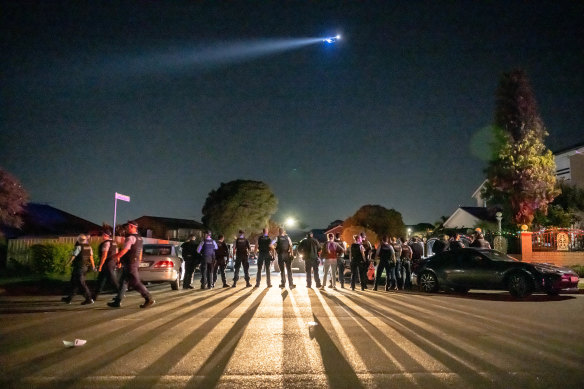- Analysis
- National
- National security
This was published 6 months ago
ASIO boss caught in political crossfire over Gaza refugees
By Deborah Snow
It’s a fair bet ASIO boss Mike Burgess might be regretting at least one part of his appearance on ABC TV’s Insiders this month.
Most of the exchange was uncontroversial, albeit revealing, especially in relation to the increasingly chaotic and hybrid nature of the threats which the spy agency is trying to stay on top of.
But it was Burgess’ remarks towards the end of the interview that set political hares running. Pressed by host David Speers on whether it was a “problem” if Gazans seeking sanctuary in Australia had expressed “rhetorical support” for terrorist group Hamas, Burgess replied, “if it’s just rhetorical support and they don’t have an ideology or support for a violent extremism ideology, then that’s not a problem; if they have a support for that ideology, that will be a problem”.

ASIO director-general of security Mike Burgess.Credit: Alex Ellinghausen
To many in the national security community, these comments seemed reasonable. One seasoned hand – a long-time senior intelligence official who did not want to publicly buy into the political debate – told The Sydney Morning Herald this week, “The mere fact that someone has a different view on the Middle East about Israel and about Hamas does not of itself lead to an adverse finding by ASIO.
“Mike was absolutely accurate. ASIO’s role is defined in legislation; they don’t operate on a layperson’s view of what is a threat or not”. Nor, the source added, was its ASIO’s job to determine what views were or were not consistent with Australian values.
Yet, as this same long-time insider lamented, “there is a degree of nuance here which politicians and commentators are just not interested in”.
Unsurprisingly, Burgess’ remarks have landed him in the midst of an increasingly bitter fight between Labor and the Coalition over whether enough is being done to screen Gazans seeking safety here from the Israeli onslaught, launched in response to the October 7 attacks.
John Howard told the Australian this week (in remarks that seemingly referenced Burgess) “I don’t think it’s good practice for senior officials, however competent, in sensitive positions to be engaging in general political debate on chat shows.”
Treasurer Jim Chalmers returned fire the next day, telling reporters “I have complete confidence in our security authorities and agencies, in particular, the director-general of ASIO”, and taking the opportunity to again brand Peter Dutton as “too divisive” to ever become prime minister.
But the saga raises a broader, rarely discussed question: how far and how often do officials in positions as sensitive as Burgess’ step into the public arena?
Burgess has raised eyebrows before, with headline-grabbing remarks in some of his previous annual threat assessments (a practice he instituted when he became ASIO head in 2019.) In 2021 he inadvertently triggered a media hunt to identify what he’d described as a “nest of spies” which the agency had disrupted (it was revealed this year they were from the Indian foreign intelligence service).
Delivering his 2024 threat assessment in February, his revelation that a former Australian politician had “sold out their country, party and former colleagues” to foreign spies had a similarly galvanising effect. Fingers were pointed at several people, none of whom were ever confirmed as the relevant ex-politician. Is this courting headlines, as some suggest? Or simply putting into practice Burgess’ mantra of enhancing “trust through transparency?”
Justin Bassi, the head of the Australian Strategic Policy Institute (ASPI), says it’s a “judgment issue [as to] the extent to which intelligence agency heads should speak [in public forums]”.
It’s critical, he says, in an era when faith in institutions has nosedived and with online disinformation proliferating that “governments and their chief officials … keep the public informed in a way that only 15, 20 years ago [would have been] unnecessary.” And he says the ASIO chief’s annual threat assessments are “consistent with what many of our partners do, so in the US, the CIA has for a long time had their formal threat assessment”.
But the issue with Burgess’ Gazan remarks, he argues, is they were left uncontextualised by others in government.
“The silence was the problem,” he says. “It should have been taken up immediately by ministers and the policy agencies to say, while someone’s extreme views may not be a matter for ASIO … the character tests of Australia’s visa system are a matter for the policy agencies. It should have been very easy for the government to say, if you support a terrorist organisation … you will fail the character test.”
Just over three weeks ago, the Albanese government raised the national terrorism threat level from “possible” to “probable”, on ASIO’s advice. It was the first time it had been raised since November 2022. Prior to that it had remained at “probable” for eight years (since 2014, the year which saw the deadly taking of hostages by gunman Man Haron Monis at the Lindt café in Sydney). ASIO defines “probable” as a greater than 50 per cent chance of an onshore attack or attack planning within the next 12 months.
Lydia Khalil, program director for transnational challenges at the Lowy Institute, says the raising of the threat level was no surprise to her. “If anything, it was an overdue acknowledgment of what the threat landscape has become,” she says, “kick-started from COVID and then the lingering effects of that intersecting in lots of ways with the digital environment, and also the impacts of overseas conflicts … there is generally a much more anti-authority, anti-government sentiment that had been brewing for a long time.”
ASPI’s John Coyne, an expert in policing and counterterrorism, also considers the raising of the threat level “probably somewhat overdue”. But he says getting the timing right is “always challenging … if you raise too soon you are viewed as being hawkish about security, if you raise it too late and there is an attack then you have got issues in relation to not warning the public. So it’s incredibly difficult.”
Standing alongside Burgess to announce the raised threat level on August 5, Prime Minister Anthony Albanese was at pains to stress that “probable” did not mean inevitable and there was no intelligence about an imminent threat.
However Burgess’ message was sobering. Painting a picture of a world where threats could materialise out of a clear blue sky, he warned that “the threats are becoming harder to predict and identify … [and] across all ideological spectrums attacks are likely to occur with little or no warning”.
That spectrum includes not just what Burgess termed “traditional religiously motivated Islamist violent extremism” but a melange of other ideologies, with individuals cherry-picking from a range of extremist ideas to curate their own dark world view.
Coyne sees that list as including white supremacists, white nationalists, anti-immigrationists, incels, misogynists, and the anti-authority movement that came out of COVID-19. Warped views deriving from a fundamentalist end-of-days version of Christianity drove the three perpetrators of the December 2022 shootings on a remote property at Wieambilla in Queensland, since designated by police as a religiously motivated terrorist attack. Overseas, al-Qaeda is on the rise again, as is the Islamic State offshoot ISIS-K in Afghanistan, heightening the risk of galvanising remote lone actors. The threat landscape, says Coyne, is “really complex”.
A recurrent theme in Burgess’ recent appearances has been the extreme youth of some radicalised individuals. Since April, ASIO has investigated eight “attacks or disruptions that have either involved alleged terrorism or have been investigated as potential acts of terrorism”, Burgess said this month. Five involved minors, the youngest 14.
He delivered no further detail, nor would ASIO provide anything further when contacted this week. However, few will have forgotten the alleged stabbing of Assyrian Bishop Mar Mari Emmanuel during a live-streamed service in the outer Sydney suburb of Wakeley on April 15, after which seven youths – still minors – were charged.
Burgess’ language around religiously motivated violence has fluctuated over time. Earlier this year he made references to Sunni violent extremism, which aggrieved sections of the Muslim community.

There was a heavy police presence in Wakeley in the aftermath of the stabbing of Bishop Mar Mari Emmanuel on April 15.Credit: Wolter Peeters
However, on Insiders he spoke more broadly of “religiously motivated violent extremism” remaining the “principal or dominant force in our caseload” while being at pains to stress the vast majority of people of Islamic faith “are not the problem”.
Prominent western Sydney Islamic community leader Dr Jamal Rifi says he’s satisfied with the language Burgess is using.
“I’ve listened to every interview he has done,” says Rifi. “He is not sugar-coating anything and we don’t want him to sugar-coat anything … his use of language has been informative and neutral.”
But it appears relations between the security agencies and other sectors of the Islamic community are still not as good as they could, or should be. Australian Federation of Islamic Councils CEO Kamalle Dabboussy said: “We have sought to have some dialogue which has not yet yielded fruits in the way that we would hope. It is not satisfactory.”
Start the day with a summary of the day’s most important and interesting stories, analysis and insights. Sign up for our Morning Edition newsletter.